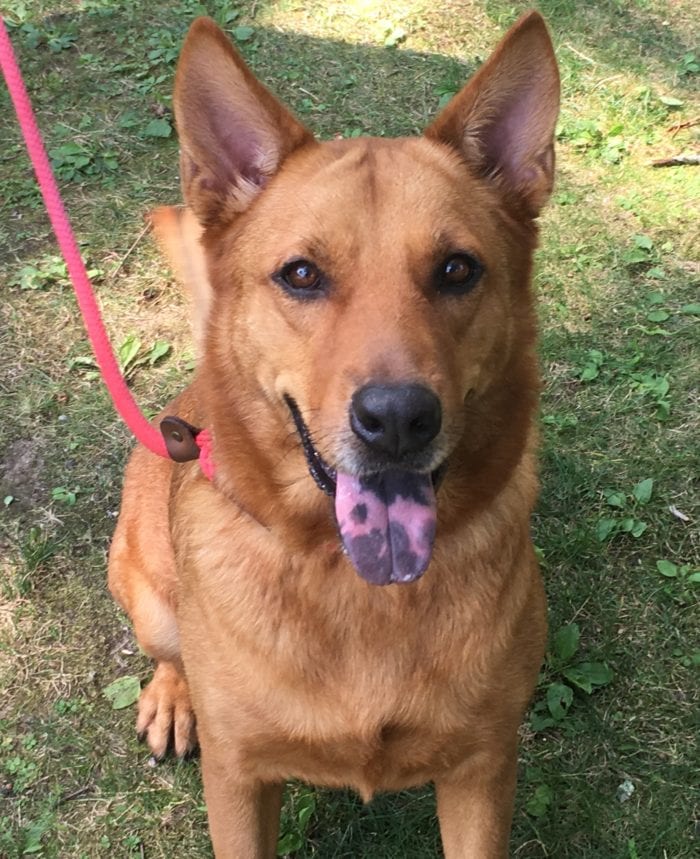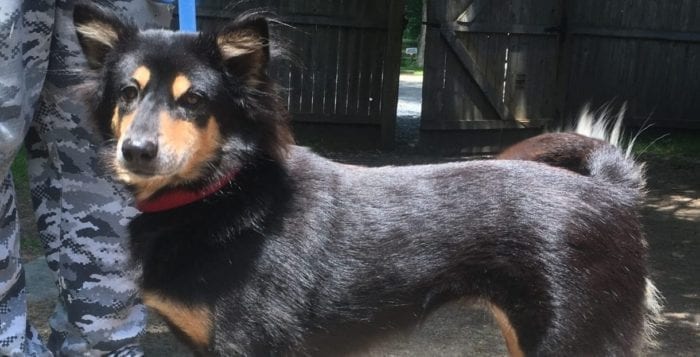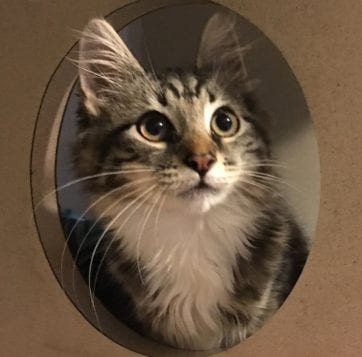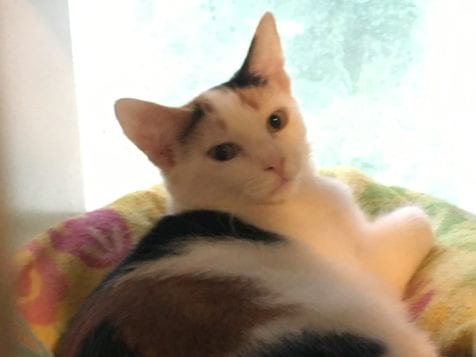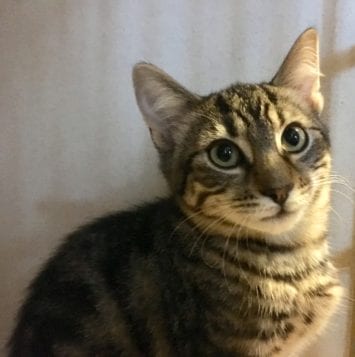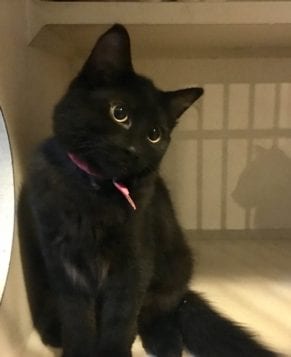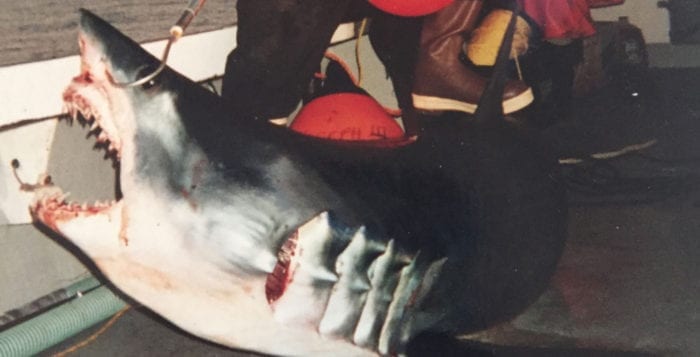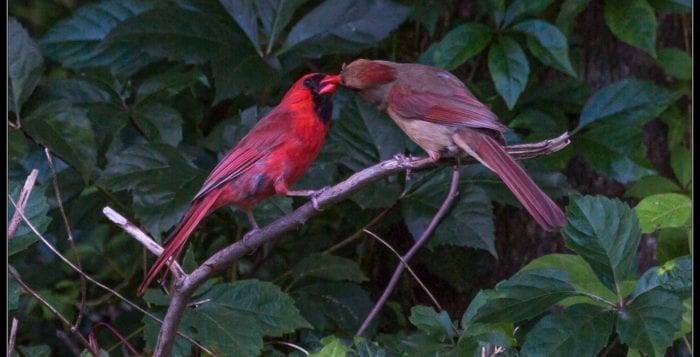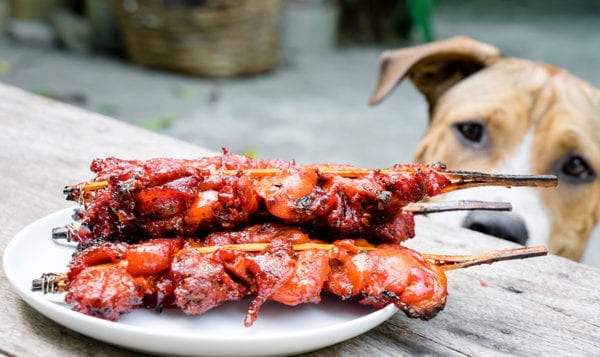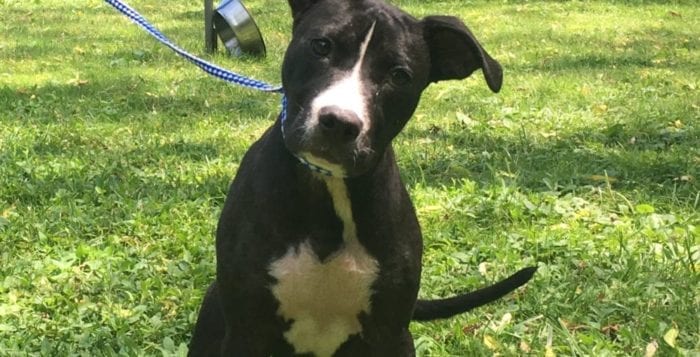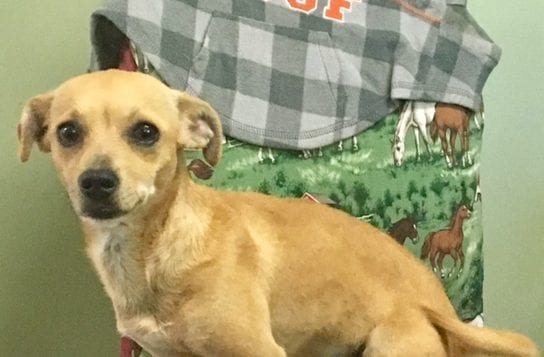MEET BRUCE! Big Bruce is the man! This handsome guy knows it all … he can sit, lay down and even roll over! A 3-year-old Shepherd mix who made it here all the way from the Cayman Islands, he is now at Kent Animal Shelter ready to find his forever home. Could that be with you? Bruce comes neutered, microchipped and up to date on all his vaccines. Kent Animal Shelter is located at 2259 River Road in Calverton. For more information on Bruce and other adoptable pets at Kent, please call 631-727-5731 or visit www.kentanimalshelter.com.
Shelter Pet of the Week: Imogen
MEET IMOGEN! This pretty little girl is Imogen, a 5-year-old shepherd mix who recently arrived at Kent Animal Shelter from Thailand, rescued from the dog meat trade where she had little to no chance of survival. She’s safe now and would love to finally have a place to call home. Please come meet this sweet girl today and show her how great life can be! Imogen comes spayed, microchipped and up to date on vaccines. Kent Animal Shelter is located at 2259 River Road in Calverton. For more information on Imogen and other adoptable pets at Kent, please call 631-727-5731 or visit www.kentanimalshelter.com.
Shelter Pets of the Week
MEET HERA, SELENA, MATTHEW AND MARY!
Look at these sweet faces! These beautiful furbabies are just a few of the adorable 3-month-old kittens available for adoption at Kent Animal Shelter, 2259 River Road, Calverton. For more information, call 631-727-5731 or visit www.kentanimalshelter.com.
Take a bite out of Shark Week, Long Island edition
By Kevin Redding
As the nation sinks its teeth into another annual Shark Week on Discovery Channel, local fishermen from across the North Shore reflected on their experiences and close calls with the predators of the sea.
Capt. James Schneider, James Joseph Fishing in Huntington
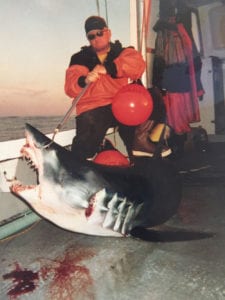
I was giant bluefin tuna fishing on our smaller, 38-foot boat around 2004 and we were off Nantucket and we pulled up on a whale. Usually the tuna swim with the whales, they eat the same bait. And we saw what looked like giant tuna and we threw a bunch of bait into the water and put three lines in. All three rods went off at the same time and we hooked up what we thought were three tuna fish at the same time for a minute. Within 10 seconds of the hookup, the first fish jumped behind the boat … it was a 650-pound mako shark that got in between the other two lines. The other “tuna fish” were a 250-pound blue shark and another mako. We were using monofilament leaders for the tuna, and the mako came down on the line and snapped the leader (fishing line). Then the shark jumped above our eye level and cleared the water 12 to 15 feet, leaped completely out of the water trying to throw the hook out of its mouth. The other one we … caught it, after an hour and a half, it was a mako that was nearly 700 pounds, snagged in the dorsal, he’s swimming, felt a lot like a tuna fish. We put it in the boat and it was on the line for about an hour and half and then we gutted it and found about nine, full-sized bluefish intact in stomach, each weighing between 8 and 13 pounds.
Another time, I was out 17 miles south of Montauk with my son when he was 8 years old. I wanted to catch my son his first shark. We went out, my son caught a mako shark pretty early in the trip. Within 20 minutes of him hanging the shark from the stern of the boat, I noticed a giant shape coming toward the boat and it was a great white shark, about 17-18 feet long, probably close to 3,000 pounds — about the width of a Volkswagen. It was cruising with such agility coming right to the boat and we had a little time so I asked my son, “Do you want your shark or do you want to watch the great white eat the shark?” My son quickly decided he wanted his shark to show his grandparents so we whipped the shark into the boat just in time as the great white came up to the stern.
Capt. Brett Clifford, Osprey Fishing Fleet in Port Jefferson
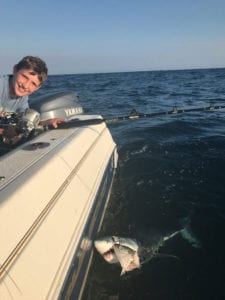
My 11-year-old son, Kieran, was excited to go shark fishing for the first time so he, myself and one of the first mates from the Osprey trailed my 25-foot Aquasport to Montauk last Wednesday, July 19. We launched there after catching some fluke, went out about 20 miles to the sharking grounds and we drifted for about five hours with very little action. My son got a chance to see a sea turtle, which was kind of cool. A mahi-mahi was on the lure for a couple minutes but we eventually lost him. All hope seemed lost and we brought in one line and then when Kieran was reeling in the last line, the float popped up and we weren’t sure if it was a wave or a shark. I picked up the line and felt little bumps, put the rod back in the holder as Kieran safely put his hand on the line so he could feel the bumps. He felt them and he looked up at me and then the shark took it and the line went off. He was able to feel the power of the shark and how fast it takes a line like that. We hooked the shark, put the rod in Kieran’s lap and had him start fighting it. It took him about 15 to 20 minutes to bring in about a 5-foot mako. Although it was a keeper, we clipped it and let it go. We put one more bait in the water and it was then immediately picked up by a blue shark, which we released. I’ve caught makos, blue sharks and thresher sharks before [but] nothing can compare to watching your own son’s excitement and feel the thrill of a big game fish like that for the first time, so that totally trumps any other shark experiences I’ve had.
Capt. Steve Witthuhn, Top Hook Fishing Charters in Montauk and frequenter of Cold Spring Harbor
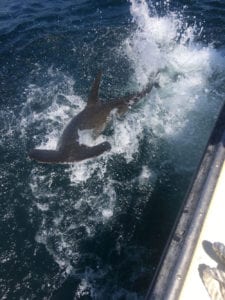
There’s a lot of bait and life out there in Montauk so it’s one of the more exceptional years for this. That’s the fishing capital of the world and you’re bound to catch something there. We had a trip Friday, July 21, where we took a father and his two boys out to an area 12 miles across Montauk Point and I saw signs of life viewing whales and dolphins in the area. There was also a sea turtle — it was like an aquarium over there. We decided to set up there and we got the baits ready, using circle hooks, and started chumming — what we call “drifting and dreaming.” You get things out there and you’re waiting for the bite and dreaming of when that shark comes into the slick and looks for the bait. Our first hit was a 150-pound blue shark and that got things rolling. The next was a 125-pound dusky.
As we’re getting another blue shark off the line, we see a big hammerhead shark swim by. Hammerheads are very finicky, sometimes they take a slab bait but normally I’ve found them to be aggressive, they want live bait. So as we hooked up a live bluefish, the bluefish got excited and started running for its life because the hammerhead was on its tail. He tore it apart. We started playing with him and put some more bluefish on the line when we saw another hammerhead come into the slick. Talk about shark-infested waters, we were in the right place at the right time. We hooked up one of the hammerheads, about a 6 or 7 footer, and we fought it for about a half hour. It ate the live bluefish and then another hammerhead appeared. Once the action starts, everybody wakes up. Once you hear that rod go “zzzzing” then everybody jumps up and wants to see what kind of shark it is. It was pretty wild.
All these sharks were caught and then released. For me as a captain, it’s more about the thrill of the catch rather than the kill of the catch. If we can respect nature then we can have a lot of fun and educate our customers. I told them, “I know Shark Week begins in a few days, but you’re experiencing something live and what it’s all about.” I’m all for respecting and preserving the resource.
Photo of the Week
LOVEBIRDS Bob Sanderson of Stony Brook recently snapped this photo of two cardinals in his backyard. He writes, “l titled this photo ‘Lovebirds,’ although I doubt if they are kissing. I had just come back from a photo shoot at West Meadow Beach and gone out to my backyard and saw a red cardinal. Just as I pointed the camera at him, the other appeared. It all took place in a matter of seconds. The timing was just dumb luck.”
Send your Photo of the Week to [email protected].
Ask the Vet: Summer barbecue hazards
By Matthew Kearns, DVM
 Aaaah, summer’s here and we know it by the smells in the air. Tantalizing aromas of steak, sausage, chicken, burgers and dogs. After dinner it’s marshmallows (sometimes with graham crackers and chocolate). I don’t know anyone who doesn’t love it (including our pets). As gratifying as it is to have friends and family over, we have to be careful of our “unofficial tasters” hanging around the barbecue.
Aaaah, summer’s here and we know it by the smells in the air. Tantalizing aromas of steak, sausage, chicken, burgers and dogs. After dinner it’s marshmallows (sometimes with graham crackers and chocolate). I don’t know anyone who doesn’t love it (including our pets). As gratifying as it is to have friends and family over, we have to be careful of our “unofficial tasters” hanging around the barbecue.
Grease
Be very careful of grease both dripping from the barbecue and on the ground. Hot grease from drippings can cause burns to the skin and mouth, and old grease can grow mold and bacteria on it. Lastly, large amounts of grease can lead to severe vomiting and diarrhea and, potentially, a life-threatening condition called pancreatitis.
Raw meat
Dogs and cats don’t always wait for the food to be cooked before they decide to jump up on the counter and take some. Although many pet owners feel that the raw diet is the way to go, for pets raw chicken and beef can have some serious bacteria like various Salmonella species and E. coli, which will proliferate in the hot summer sun.
Foreign bodies
A foreign body in this context refers to anything a pet would be silly enough to swallow that will get stuck in the gastrointestinal tract. Common foreign body risks at barbecues are corn cobs (my favorite because you can see them on X-rays and know what they are), peach pits, aluminum foil, plastic wrap, string to bind roasts, bones (chicken, pork, beef) and skewers (wood or bamboo for shish kebab or teriyaki). Bones and skewers are the most dangerous because they not only have the potential to form an obstruction but can also penetrate the esophagus, stomach or intestines and lead to a life-threatening peritonitis.
Toxicity
Things like onions and garlic can cause significant gastrointestinal upset and, in larger amounts, GI bleeding. Fruit salads that contain grapes and snack mixes that contain raisins and toxic nuts like macadamias should be kept out of reach of our pets. Any fruits with pits should be either avoided (see “Foreign bodies” above) or carefully picked up. Things like ice cream and chocolate should also be kept away from pets. Large amounts of chocolate could lead to serious issues besides just an upset tummy (things like irregular heart rhythms, seizures, difficulty breathing) and, although most dogs tolerate dairy products, some are lactose intolerant (almost all cats are lactose intolerant as adults).
Heatstroke and burns
Pets (dogs particularly) may stay close to the barbecue even if it is out in the sun to be close to potential scraps. These guys don’t have the option to take off their coats, so make sure that plenty of water (with a few ice cubes is nice) is available and also make sure your pets have access to inside or the shade. Also remember that those grills can remain quite hot (especially charcoal grills) long after the barbecue is over, so make sure your pets do not have access to that area when no one is actually either grilling or monitoring that area. So, have fun in the sun and LIGHT THOSE GRILLS!!!! Just make sure our pets are not too close when you do.
Dr. Kearns practices veterinary medicine from his Port Jefferson office and is pictured with his son Matthew and their dog Jasmine.
The story behind the dog that saved a deer in Port Jeff Harbor
Suffolk County Executive presents Setauket pet with proclamation
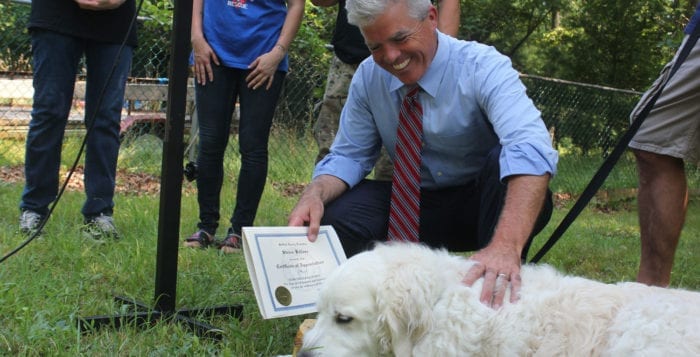
A local English golden retriever has earned a lifetime of “Good boy!” declarations and belly rubs, but Suffolk County recently threw him another bone to add to the accolades.
Suffolk County’s newest hero Storm, the brave, 6-year-old dog, who became a national celebrity last week after a video of him pulling a drowning fawn from Port Jefferson Harbor Sunday, July 16, spread like wildfire online, rolled around in the grass outside the Save the Animal Rescue Foundation in Middle Island July 19 as he and local animal rescue members were honored for their efforts to save the baby deer.
County Executive Steve Bellone (D) presented proclamations to East Setauket resident and injury attorney Mark Freeley, Storm’s owner who captured the heroics on his cellphone, Strong Island Animal Rescue League co-founder Frankie Floridia, who aided in the rescue, and Save the Animal Rescue Foundation Director Lori Ketcham, who is rehabilitating the 3-month-old male fawn now referred to as Water. He is currently in stable condition.
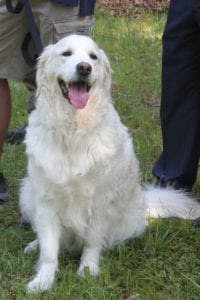
Despite an attempt to present an official proclamation to the man’s best friend of the hour, Storm seemed much more interested in a large bone provided by the county executive’s staff.
“We’re here to talk about some of the heroes we have here, both canine and human, for what they’ve done to really remind us of the importance of compassion and giving to others and helping others,” Bellone said, acknowledging the selfless initiatives of the animal rescue groups.
Looking down at Storm, he said, “And this dog here is no ordinary golden retriever. He really did something important and special for us. The inspiration that Storm has given to all of us should inspire us to support the work of people like this that is happening each and every day. If that happens, then what Storm did will not only help save one fawn but will help save countless other animals here and others that will be here in the future.”
It was just another normal Sunday morning walk out to Pirate’s Cove for Freeley, 53, and his dogs, Storm and Sarah, a rescued Border collie, when he said the golden retriever suddenly got ahead of him on the empty beach.
The next thing Freeley knew, Storm was paddling out into the water about 100 feet offshore toward “a brown head bobbing” he quickly realized was a drowning fawn. As captured in the video seen around the world, Storm held the deer in his mouth and carried it towards the beach “like a lifeguard would with their arm,” Freeley said.
After the fawn got on the sand, it ran around wildly before collapsing. Storm gently nudged the deer’s face and belly and pawed his leg.
“He won’t even play fetch with a tennis ball,” Freeley said, laughing. “I just feel like he thought he had to do something for this deer. Storm’s a very well-adjusted and socialized dog. He doesn’t have a mean bone in his body and he gets along with all animals. People on Facebook were saying he was going to kill the deer, but if you meet this dog, you know that was not going to happen. He’s not prey-driven.”
Freeley quickly posted the video to his Facebook and then called the nonprofit Strong Island Animal Rescue League to inform its members of the fawn.
Floridia, the group’s leader, said when he and his colleague Erica Kutzing tried to approach the deer with leashes and nets, “it totally went AWOL” and ran back into the water and paddled more than 200 feet out. Floridia said it was a do-or-die situation and it didn’t take long before he was swimming out to save the deer.
“He went into the water and followed the example that Storm set earlier and brought that fawn back in and brought it to safety,” Bellone said of Floridia, who he called the animal rescue cowboy.
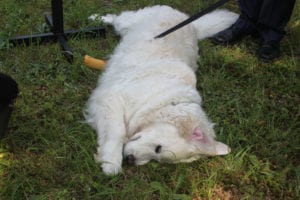
The deer was then transported to the Middle Island animal rescue center.
“The deer was saved and that’s really the best part of the whole thing,” Floridia said. “It’s wonderful that this is bringing awareness to what really happens behind the scenes. Of course I want to thank Storm for helping us ride this wave to get awareness for what we do every day.”
Since the video was posted, the courageous canine’s heroics has accumulated nearly 5.5 million views on Facebook, has been the top story on several talk shows, including ones overseas.
“We’ve been going from one interview to the next and Storm’s been a champ at everything,” Freeley said. “Yesterday, a lady out of the blue called me to tell me just how much of an impact the video had on her, and I could hear her crying a little bit. It’s just amazing and I think people just want to see a simple, basic act of kindness by a dog because news is so hostile today.”
Ketcham said she appreciates the attention her center has been getting from this, which she admitted she isn’t used to.
“It’s been a crazy couple of days since the fawn came here,” Ketcham said. “We have several hundred animals here in our care all being taken care of by a dedicated bunch of volunteers. We hope to get the fawn outside with the rest that are there in a couple days and then back out into the wild in September.”
Freeley, who fosters rescue dogs, provides pro bono legal work for a local animal rescue group, and runs adoption events every Saturday with his daughter, reiterated the biggest takeaway from this.
“It’s really important to support people like Frankie and [these foundations] because they’re the front lines of animal rescue and everybody wants animal rescue, but without your support, there can’t be animal rescue,” he said. “So if Storm has one thing to ask you today it’s to donate to Strong Island and Save the Animal Rescue Foundation to help them continue to save the lives of animals in Suffolk County and on Long Island.”
Heroic Setauket dog goes viral, to be honored by county executive
A brave dog took Port Jefferson Harbor by storm to rescue a flailing fawn July 16, and as a result has become a national celebrity. A video was posted on Facebook Sunday morning of Storm, a dog owned by Setauket resident Mark Freeley, bounding into Port Jeff harbor to rescue a drowning baby deer as Freeley watched from the shore and urged his dog to bring the deer in. By Wednesday, several million shares and views later, the video had gone viral and Storm was set to be honored by Suffolk County Executive Steve Bellone (D). Freeley said it best at the conclusion of the one-minute video: “Good boy, Storm!” Check back next week for a full story on the local hero.
Shelter Pet of the Week: Delilah
MEET DELILAH!

This sweet girl is Delilah. A 6-month-old terrier/border collie mix, she was rescued from a high-kill shelter in South Carolina and brought to Kent Animal Shelter. She’s safe now and just dreams of the day when she will have a loving home to call her own. We’re sure Delilah will be one of the best pups you will ever meet! All she wants is to cuddle and give LOTS of kisses. Delilah comes spayed, microchipped and up to date on vaccines. Why not drop by and say hello? Kent Animal Shelter is located at 2259 River Road in Calverton. For more information on Delilah and other adoptable pets at Kent, please call 631-727-5731 or visit www.kentanimalshelter.com.
Update: Delilah has been adopted!
Shelter Pet of the Week: Lady
MEET LADY! This pretty little girl is Lady, a 2-year-old Chihuahua mix, currently waiting for adoption at Kent Animal Shelter. At just 11 pounds, she is the perfect lap dog who loves to give kisses and snuggle. Dubbed “a ray of sunshine” by her caretakers, Lady loves people, other dogs and going for walks. She is up to date on all her vaccines. Won’t you come by and say hello? You’re sure to get a kiss! Kent Animal Shelter is located at 2259 River Road in Calverton. For more information on Lady and other adoptable pets at Kent, please call 631-727-5731 or visit www.kentanimalshelter.com.
Update: Lady has been adopted!


